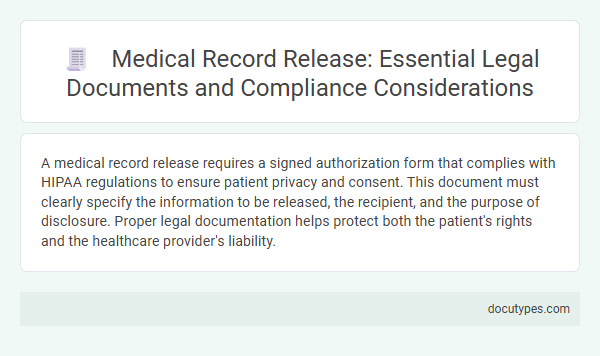A medical record release requires a signed authorization form that complies with HIPAA regulations to ensure patient privacy and consent. This document must clearly specify the information to be released, the recipient, and the purpose of disclosure. Proper legal documentation helps protect both the patient's rights and the healthcare provider's liability.
Introduction to Medical Record Release
Medical record release is a critical process ensuring patient privacy while allowing authorized access to health information. Understanding the legal document required for this release is essential for compliance with healthcare regulations.
- Authorization Form - A signed document by the patient permitting healthcare providers to share medical records with specified parties.
- HIPAA Release Form - A standardized legal form complying with the Health Insurance Portability and Accountability Act to safeguard patient information during disclosure.
- Power of Attorney - A legal document granting an individual the authority to manage medical records on behalf of a patient unable to provide consent.
Key Legal Documents Required for Medical Record Release
| Legal Document | Purpose | Key Details |
|---|---|---|
| Medical Record Release Authorization Form | Grants permission for healthcare providers to share medical records | Must include patient's full name, date of birth, specific records to release, purpose, recipient details, and signature |
| HIPAA Release Form | Ensures compliance with the Health Insurance Portability and Accountability Act | Specifies scope of information disclosed and duration of authorization; protects patient privacy rights |
| Power of Attorney for Healthcare | Allows a designated person to access and manage medical records on behalf of the patient | Legal document appointing an agent for health decisions; often requires notarization |
| Court Order or Subpoena | Authorizes release of medical records through legal mandate | Issued by a court; used in legal proceedings or investigations |
| Death Certificate | Permits release of medical records of deceased individuals to authorized parties | Required when requesting records post-mortem; verifies identity and relationship to deceased |
HIPAA Compliance and Patient Privacy
The primary legal document required for medical record release is a HIPAA-compliant Authorization Form. This form ensures the patient's explicit consent for sharing their protected health information (PHI) with designated parties.
The Authorization Form must include specific details such as the patient's name, the information to be disclosed, the recipient of the records, and the purpose of the disclosure. HIPAA regulations mandate that this document protects patient privacy by restricting unauthorized access. Healthcare providers must retain the signed Authorization Form as proof of compliance and patient consent during the release process.
Obtaining Patient Authorization: Guidelines and Forms
To obtain medical records legally, a patient authorization form is required, specifying the information to be released and the recipient. This document must include the patient's signature, date, and details about the scope and purpose of the record release. Healthcare providers typically use standardized authorization forms compliant with HIPAA regulations to ensure patient privacy and consent are maintained.
Exceptions to Consent: When Release Is Permitted Without Authorization
Medical record release typically requires a signed authorization form to protect patient privacy. Certain exceptions allow healthcare providers to share records without your explicit consent under specific circumstances.
- Legal Requirements - Court orders or subpoenas compel the release of medical records without patient authorization.
- Public Health Reporting - Records may be shared with public health authorities for disease control and prevention purposes.
- Emergency Situations - Health professionals can disclose information without consent to provide necessary treatment during emergencies.
State and Federal Regulations Impacting Medical Record Release
The primary legal document required for medical record release is a signed Authorization for Release of Health Information form, complying with HIPAA regulations. State laws may impose additional requirements, such as specific consent forms or notarization, varying by jurisdiction. Federal regulations mandate strict patient privacy protections and set limits on the scope and purpose of medical record disclosures.
Documentation Retention and Recordkeeping Requirements
A signed authorization form is the primary legal document required for the release of medical records. Proper documentation retention and recordkeeping protocols ensure compliance with healthcare regulations and protect patient privacy.
- Authorization Form - You must obtain a valid signed consent from the patient or their legal representative to release medical records.
- Retention Period - Medical records must be retained for a minimum period defined by state law, typically ranging from 5 to 10 years.
- Recordkeeping Requirements - Healthcare providers are required to maintain detailed logs of all medical record disclosures to ensure traceability and accountability.
Maintaining meticulous documentation supports legal compliance and safeguards patients' rights during medical record release.
Third-Party Requests: Legal and Ethical Considerations
What legal document is required for releasing medical records to third parties? A signed authorization form from the patient is essential for compliance with privacy laws such as HIPAA. This document must specify the recipient, purpose, and scope of information to ensure legal and ethical standards are met.
Common Pitfalls and How to Avoid Legal Risks
Obtaining a proper legal document is essential for the release of medical records, typically a signed medical records authorization form is required. This form must comply with the Health Insurance Portability and Accountability Act (HIPAA) standards to ensure patient privacy and consent.
Common pitfalls include incomplete authorization forms, missing patient signatures, and unclear scope of disclosure, which can lead to legal repercussions and delayed records release. To avoid these risks, medical providers should use standardized forms clearly specifying the recipient, purpose, and type of information authorized for release.
What Legal Document Is Needed for Medical Record Release? Infographic

